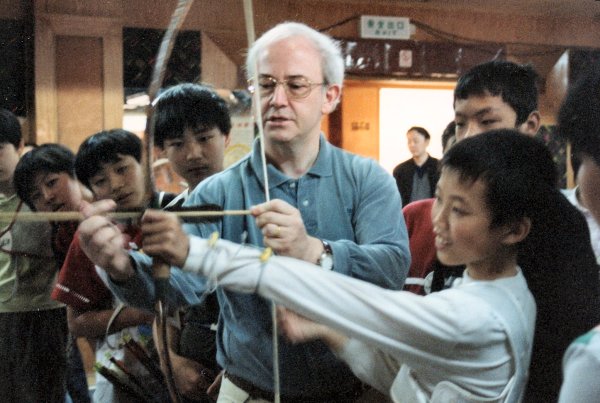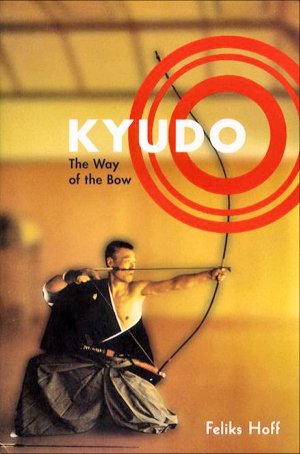
Asian Traditional Archery Research Network (ATARN)
Text and
photographs © Stephen Selby, 2001 - 2002.
A1, Cloudridge,
30, Plunkett’s Road,
The Peak, Hong Kong.
Fax: (852) 2808-2887
email: srselby@atarn.org
May 2002
Dear All,
ATARN is gearing up our out-reach in China.
From 12 - 15 April, I went with a television crew to continue working on a documentary about Ju Yuan Hao. This was a follow-up to a visit late last year, and we filled in some blanks that we had left in our last round of filming. All the items on our 'storyboard' have now been covered.
Next we went to a training session for young archers. The group are all undergoing intensive training in FITA archery for the 2008 Olympics. They do two hours' training every day, and a whole-day session on Saturdays!
Their club was an indoor range. It was rather cramped. We filmed the young people during their practice session, and then I took out a Ju Yuan Hao training bow (woefully weak, bamboo only!) and allowed the kids to have a go.
Their excitement was palpable. All these kids know that the bow and arrow are an ancient weapon of the Chinese people; but none had ever had a chance to handle traditional equipment. The TV crew interviewed them. Some said they would definitely want to learn traditional Chinese archery, because their type of regular FITA training lacked variety. They believed they could learn something from old Chinese techniques.
I took along Ting Ting, the great-granddaughter of the Chengdu Bowyer, Wu Shu Sen. She had never handled a bow of any sort in her life. With the young archers watching, I helped her to set up a shot and fire two arrows. Determined not to let her side down, she kept a perfectly erect stance and held the bow proudly.
Afterwards, when the TV crew asked her how she felt, tears rolled down her cheeks -
"I never realized what my ancestors had done in the past. It was such an emotional experience for me to handle a bow for the first time, knowing that my great grandfather had been a famous archer, and my grandmother had been a prizewinner in a national archery competition. I didn't know any of this until Stephen told me. How could we have abandoned such a glorious tradition in our Country. I am determined to learn archery!"

I have decided to hold a camp in Peking in the winter to introduce youngsters to traditional Chinese archery. Ju Yuan Hao's bows are too fine and expensive for beginner training for kids. I am ordering 100 very simple reproduction Chinese bows in glass fiber from a well-known factory (don't ask me the name or the price: it's a secret deal!). The bows will be donated to the Chinese National Archery Association to be lent out for training and practice by young archers. When the kids are used to them, they can order from Ju Yuan Hao if they want (and can afford to).
This project is going to cost more than US$10,000. I shall seek sponsors in Hong Kong; but I and the Chinese Archery Association would warmly welcome any offers of donations from ATARN Members to help out.
Another filming experience was not so happy. In the couple of days before its demolition, we filmed the old "Bow and Arrow Association Hall". The hall was originally the site of the ancestral temple venerating Xuan Yuan, the patron-god of the bowyers' trade in Peking. It was also a sort of guild hall for the bow-makers. The building was not particularly old, having burned down several times. It was last reconstructed in the 1960s, and used up until the Cultural Revolution for the annual ceremonies for the birthday of Xuan Yuan (24th day of the fifth month.) Some of the old people sitting around remembers the Association Hall. Seventy-five-year-old Mrs. Qiu had been employed as a cleaner and watchman for the Hall in the old days.
|
|
|
|
After demolition, it will no longer be possible to find the original location on which it stood. It is sad to loose yet another landmark of Chinese archery. But if we can start to build a love of traditional archery among young people in Peking, I will feel better about it.
This month marks an important development: I am undertaking a visit to Qinghai (north of Tibet) and Xinjiang to study the situation of traditional archery there.
Qinghai has regular, traditional shooting competitions among the Tibetan people. There are also one or two traditional bow and arrow makers there. In Urumqi, we hope to examine bows and arrows found together with the desiccated mummies of the Tarim Basin. Near Ili, there is a settlement of Manchus who still maintain a traditional archery festival (but using western bows.) There are also two craftsmen who used to make traditional bows, but have stopped due to lack of the proper materials. I have asked them to make me models of the bows they used to make, so that I can see the appearance.
Please be patient for the next newsletter, as it will take me some time to digest and arrange our materials.
BOOK REVIEW
Feliks Hoff, 'Kyudo: The Way of the Bow'. Shambhala Publications Inc. Boston/London, 2002. ISBN 1-57062-852-1. Paperback. 255 pages. US 19.95.

This volume by Feliks Hoff is an English translation of Hoff's book, 'Kyudo: Die Kunst des japanischen Bogenschießens' published in 1999 by Verlag Weinmann, Berlin.
I am not a Kyudo practitioner, so I am certainly not in a position to criticize the text. But the book is an instruction manual for the novice learner, and I have read it from that point of view.
Hoff's book is a methodical instruction manual for the Kyudo style of the Heki School. It goes through a brief history of Kyudo, the lay-out and etiquette of the Dojo (practice hall), the bow, bowstring, arrows, quivers, dress and accessories. Then it takes you step-by-step through technique, correction of mistakes, competition forms and examination forms, together with a description (without detailed explanation) of other special forms such as military shooting and yabusame (horseback archery.)
There are plenty of photographs and line drawings, vital to help the learner to grasp the subject matter. Most of them are clear, although sometimes the author tries to concentrate too much information into one diagram. An example is a diagram (p. 129) summarizing the effects of different errors on the outcome of the shot. The reader has to look up numbers on the diagram against quite a complex table of 80 different errors. Some errors (e.g. #74 'use of a glove that does not fit') are omitted from the diagram altogether (perhaps the glove comes off before the arrow even gets fired!) The diagram about aiming (fig. 11.4), while less complex, is labelled with transliterated Japanese terms that refer to various stages in setting up the shot, then jumps to an English term, 'full moon', that I could not find explained at all.
I was curious (although this is not a criticism) about the explanation of the step in which the archer has to 'turn the edge of the bow to the left' out of the path of the string at the moment of release to stop the arrow from 'being diverted considerably to the right at the last moment'. Such an action is not required in Chinese archery (or as far as I know, in English longbow shooting), although the arrow-pass is much more pronounced than on a yumi, due to the effect of the 'archer's paradox'.
That archer's paradox is at play in Kyudo is evident from the fact that the string is drawn well behind the archer's ear at full draw, without any risk of the string slicing it off. (I have tried this and I know it to be the case.) I remain to be educated on this point.
The appearance of Hoff's book begs the question of how it should be compared with Hideharu Onuma and Dan and Jackie DeProspero's 'Kyudo: the Essence and Practice of Japanese Archery.' (Kodansha International, 1993.)
This is a difficult question to answer other than at the superficial level that 'Kyudo: Essence and Practice of Japanese Archery' is a more luxurious publication in terms of production and is thus rather higher-priced ($32). I rather prefer the series of visualizations in the DeProsperos' book to the composite illustrations in Hoff. On the other hand, Hoff's exposition of the history of Kyudo is more satisfactory than the DePropseros' one, and Hoff explains many technical points in greater depth.
Both Hoff's and the DeProsperos' books end with a short essay by a master. In Hoff's case, it is by the Master Genshiro Inagaki and in the DeProsperos', it is an interview with late Master Onuma Hideharu. It is int
eresting that both are tangentially concerned with diplomatically divesting Kyudo of the some of the baggage of Zen loaded on by Eugen Herrigel and subsequently re-absorbed in Japan. (See the gentle debunking by Yamada Shōji: 'The Myth of Zen in the Art of Archery'. Trans. Earl Hartmann and Ed. William Bodiford. Japanese Journal of Religious Studies, 2001 28/1-2. ISSN 0304-1042.)Recently visiting California, I was surprised to learn that joining a tuition class for Kyudo is no easy matter. Kyudo seemed so Californian. As it turns out, the aspirant student has to join a weekend camp and then rely on private practice and occasional refresher camps.
In these circumstances, good training manuals are vital to reinforce teaching and support self-learning. Hoff's book serves this purpose with great thoroughness. I am sure that students will find it a valuable addition to the very limited English-language resources currently available (basically DeProspero together with the 'Kyudo Manual' of the All Nippon Kyudo Federation. Tokyo, 1994, and the very brief 'Japanese Archery' by William Acker. Charles Tuttle, Rutland Vermont and Tokyo, 1965.)
You will recall my description of a Warring States period longbow in one of my previous newsletters. I have prepared a zoomable .svg image of the longbow here. Subsequently, I reported on ATARNet that a Hong Kong Museum of History curator, Mr W. F. Lai, had analyzed samples of the wood from the bow and found that the species is Cudrania tricuspidata ('zhe mu'.) This is the species mentioned in the Chinese Classics as being the most desirable for bow-making:
"There are said to be seven
materials for the construction of the bow-staves. In order of quality, they are:
Zhe
(Cudrania tricuspidata), Wild
Mulberry, Chinese
Orange , Papaya (Carica papaya), Thornwood
, and lastly bamboo."
(Zhou Li (The Rituals of Zhou), Dong Guan 'Gong Ren Wei Gong'.)
In December 2000, I judged the bow to date from the Western Han period (206BCE to 8CE).
Now, thanks to the efforts of the Hong Kong Museum of Coastal Defence who have commissioned a Carbon 14 dating from New Zealand, we have a fairly definitive dating: the bow dates from about 2300 years ago - in other words the end of the Warring States period. Not only does the use of Zhe wood corroborate the details of the 'Rites of Zhou', the bow actually dates from approximately the time that the 'Rites of Zhou' was thought to have been composed in the State of Qi.
This means we must revise any idea that high-class bows were all composite bows in ancient China. (Yang Hong states that only bamboo bows have been found in the state of Chu - renowned for its archers.) That this is not just a scaled-down item for burial purposes there can be no doubt. Dr. Grayson has inspected it and feels that it was made by a skilled longbow craftsman. The shape of he bow and the use of the grain of the wood are surprisingly similar to the Holmgaard Bow excavated in Sweden. ('The Traditional Bowyers' Bible', Vol. 2. (Ed. Jim Hamm, Bois d'Arc Press, 1993.p. 91 )
|
|
(Signed) (Stephen Selby) |